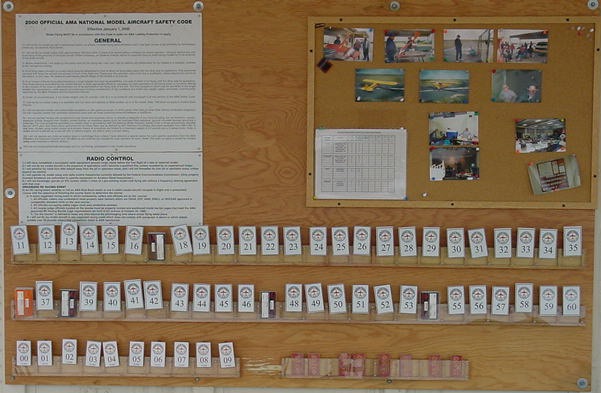Courtesy and Safety Rules
Each Member's Current MCRC Club Card and AMA license (or a
legible copy or verification of their valid application for an AMA
license), must both be inserted and publicly displayed in
the proper slot of the frequency Control Board when any Member is
operating a Transmitter at the Field. All TXs must be rechecked for
storage /transportation arriving and leaving the field.
Guest Pilots and event participants using Club
Facilities must be current AMA Members. Those AMA Members from outside
our Club may fly at our site on an occasional basis when invited by a Club
Member, who willingly accepts all legal financial responsibilities for any
accident to persons and/or property incurred by the Guest during this
invited period.
All AMA and FCC Safety Rules are always in
effect.
Frequency Control will be maintained! No Transmitter
will be turned ON without the proper Frequency Pin being attached
and displayed upon the Club Member's person, transmitter or flight box.
A Frequency Pin will not be removed from any Transmitter
without assuring that the Transmitter is turned OFF, that the
antenna is collapsed and the Transmitter owner is notified of the removal
of the Frequency Control Pin.
When many Club Members are flying and others are waiting
their turn, all Frequency Pins will be returned to the Frequency Control
Board immediately after Transmitter shut-down. Do not �Hog the Pin!�

Violation of Frequency Control Procedures will result in
the Violator being held responsible for the satisfactory restitution for
property damages caused by improper transmitter operation.
Student Pilots must have the assistance of an Instructor
Pilot until properly �Soloed�. Low-time pilots must recognize that their
inexperienced flying abilities may constitute a hazard to other people and
property.
Aircraft and Engines
1). Model aircraft will be equipped with a spinner
or Safety Nut as required.
2). Muffling devices of all engines will conform to
the AMA sound parameters.
3). All new or rebuilt aircraft should be closely
inspected by an Instructor Pilot prior to test flight(s) unless the
aircraft was built by a highly experienced builder/pilot. This requirement
is especially important when many people are present at the Field. (Note.)
Expert pilots should allow some clear air time for test flights of such
aircraft. Engine sounds, lack of distraction and easy airplane visibility
are very important for successful test flights!
4). Engine start/run up will be made with the nose
of the aircraft positioned towards the Safety Fence. Please make all
efforts to minimize the effect of a strong prop blast toward spectators,
other aircraft and flight boxes. Large models with big engines should be
started with the use of tie-down ropes with the aircraft securely tied or
held in position by an assistant at the extreme ends of the Chainlink
Safety Fence.
5). Prolonged engine operation for adjustments or
engine break-in should be performed downwind, distant from aircraft and
people.
Flying
1). Aircraft taxiing will be done with great regard
to Safety and to the effects of prop-blast, especially when aircraft
taxiing is performed from the �pit area�.
2). Call out your intentions to enter the runway,
to make touch-and-goes, to land, etc.. Airplanes on landing approach
shall have the right-of-way.
3). Clear the immediate airspace for airplanes
making a �Dead-Stick� engine-out landing approach! Unless it is
obvious that all pilots have heard the �Dead-Stick� call, Pilots further
down the line shall repeat the Dead-Stick call! Pilots are advised to move
back from the regular Piloting Area upon hearing the emergency call
warning all Pilots of an impending power-off landing.
4). Do not stand closer to the runway than the
Safety Stripes painted on theTaxi Strips during take-off, flying or
landing. A Student with an Instructor may be permitted to do
otherwise for take-off only after the Instructor Pilot has assured that
all pilots are aware of the intent to position a Student on the active
runway. After level-off, the Instructor and Student must immediately move
to a position behind the Safety Line. NOTE: The Safety Line
establishes the minimum distance from the runway when flying. It is
recommended that Fliers position themselves further back from the runway
if it is comfortable for them to do so.
5). Do not walk upon the runway or into the
approach area until other Pilots are aware of your intent to do so.
Do not remain in these areas for any longer than absolutely necessary.
Call �Runway clear!� as soon as you have left these
hazardous areas.
6). Absolutely no flying shall be
accomplished over the piloting areas, the pits, the spectator areas, the
high antenna towers to the right of the field, the parking areas or the
road! Flying should not be accomplished any closer than the far side
of the runway. All farm equipment, all people and animals are to be
avoided at all times! Low passes over the active runway are not allowed
when other aircraft are taxiing, taking-off or landing. Expert �Show-Off�
flying must be performed sufficiently distant from the pits and the
parking area to allow for Safety!
7). On busy days each pilot will have an
experienced Spotter/Observer with him in the piloting area to advise
him of hazardous situations.
8). Be especially considerate of Inexperienced and
Student Pilots. Give them time and space in which to fly and learn.
Experienced Pilots are responsible for avoidance of mid-air collisions
with Student's aircraft.
9). When fast planes are in the air, spectators
should watch them continually! High-speed airplanes can approach
spectators very fast if control is lost!
10). Review and adherence to AMA Safety Rules is
mandatory.
Guests
1). Spectators are welcome at any time that the
field is open. Spectators must always be alert to fast airplanes!
2). Fliers will supervise their Guests and are
legally responsible for their Guest's actions and their Safety.
3). Be especially alert to the activities and
movements of children and pets.

